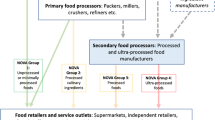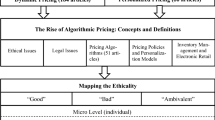Abstract
New Institutional Theory is used to explain the context for argumentation in modern practice. The illustration of Direct to Consumer Drug advertising is deployed to show how communicative argument between a doctor and patient is influenced by force exogenous to the practice of medicine. The essay shows how strategic maneuvering shifts the burden of proof within institutional relations.
Similar content being viewed by others
References
Aikin, K.J., J.L. Swasy, and A. Braman. 2004. Patient and physician attitudes and behaviors associated with DTC promotion of prescription drugs: Summary of FDA survey research results. Washington, DC: Food and Drug Administration. Retrieved January 29, 2008, from http://www.fda.gov/cder/ddmac/Final%20Report/FRFinalExSu1119042.pdf.
Berndt, E.R. 2005. To inform or persuade? Direct-to-consumer advertising of prescription drugs. The New England Journal of Medicine 352: 325–329.
Calfee, J.E. 2002. Public policy issues in direct-to-consumer advertising of prescription drugs. Journal of Policy & Marketing 21: 174–193.
Center for Medical Consumers. 2007. Rein in those deceptive drug ads. Retrieved January 29, 2008 from http://www.medicalconsumers.org/pages/CMCTOFDAREININTHOSEDECEPTIVEDRUGADS.html.
Cohen, E.P. 1990. Are pharmaceutical ads good medicine? Business and Society Review 2: 8–10.
Eisenstadt, S.N. 1968. Social institutions: The concept. In International encyclopedia of the social sciences, ed. D. Sills, Vol. 14, 401–420. New York: MacMillan.
Fligstein, N. 1991. The structural transformation of American industry. In The new institutionalism in organizational analysis, ed. W.W. Powell and P.T. DiMaggio, 311–336. Chicago: The University of Chicago Press.
Friedland, R., and R.R. Alford. 1991. Bringing society back in symbols, practices, institutional contradictions. In The new institutionalism in organizational analysis, ed. W.W. Powell and P.J. DiMaggio, 232–265. Chicago: The University of Chicago Press.
Habermas, J. 1983. The theory of communicative action: System and lifeworld (trans: McCarthy, Thomas). Cambridge: MIT University Press.
Harker, M., and D. Harker. 2007. Direct-to-consumer advertising of prescription medicines: A systematic review of the evidence from the perspective of the consumer. Journal of Medical Marketing 7: 45–54.
Harremoes, P., D. Gee, M. MacGarvin, A. Stirling, J. Keys, B. Wynne, and V.S. Guedes (Eds.). 2002. The precautionary principle in the twentieth century: Late lessons from early warnings. London: Earthscan.
Haveman, H.A. 2000. The future of organizational sociology: Forging ties among paradigms. Contemporary Sociology 29: 476–486.
Meyer, J.W., and B. Rowan. 1991. Institutionalized organizations: Formal structure as myth and ceremony. In The new institutionalism in organizational analysis, ed. W.W. Powell and P.J. DiMaggio, 41–62. Chicago: The University of Chicago Press.
Mintzes, B. et al. 2002. Influence to direct to consumer pharmaceutical advertising and patients’ requests on prescribing decisions: Two site cross sectional survey. British Medical Journal 324: 278–279.
North, D.C. 1991. Institutions. Journal of Economic Perspectives 5: 97–112.
Parsons, T. 1960. Structure and process in modern societies. Glencoe, IL: Free Press.
Perelman, C., and L. Olbrechts-Tyteca. 1969. The new rhetoric: A treatise on argumentation. (J. Wilkinson and P. Weaver, Trans.). Notre Dame: University of Notre Dame Press.
Perri, M., and W.M. Dickson. 1987. Direct to consumer prescription drug advertising: Consumer attitudes and physician reaction. Journal of Pharmaceutical Marketing & Management 2(1): 3–23.
Powell, W.W., and P.J. DiMaggio (Eds.). 1991. The new institutionalism in organizational analysis. Chicago: The University of Chicago Press.
Roth, M.S. 1996. Patterns in direct-to-consumer prescription drug print advertising and their public policy implications. Journal of Public Policy & Marketing 15: 63–75.
Schuman, M.C. 1995. Managing legitimacy: Strategic and institutional approaches. Academy of Management Review 20: 571–610.
Simon, H.A. 1986. Rationality in psychology and economics. The Journal of Business 59: S209–S224.
Suddaby, R., and T. Greenwood. 2005. Rhetorical strategies of legitimacy. Administrative Science Quarterly 50: 35–76.
Thornton, P.H., and W. Ocasio. 1999. Institutional logics and the historical contingency of power in organizations: Executive succession in the higher education publishing industry, 1958–1990. The American Journal of Sociology 105: 801–843.
van Eemeren, F.H. (Ed.). 2002. Advances in pragma-dialectics. New Port News, VA: Vale Press.
van Eemeren, F.H., and R. Grootendorst. 2004. A systematic theory of argumentation: The pragma-dialectical approach. Cambridge: University Press.
van Eemeren, F.H., and P. Houtlosser. 2002. Strategic maneuvering with the burden of proof. In Advances in pragma-dialectics, ed. F. H. van Eemeren, 13–28. New Port News, VA: Vale Press.
Villanueva, P., and J. Librero. 2003. Accuracy of pharmaceutical advertising in medical journals. The Lancet 361: 27–31.
Williams, J.R., and P.J. Hensel. 1995. Direct-to-consumer advertising of prescription drugs. Journal of Health Care Marketing. 15: 14–41.
Woloshin, S., L. Schwart, J. Tremmel, and H. Welch. 2001. Direct-to-consumer advertisements for prescription drugs: What are Americans being sold?. The Lancet 358: 1141–1146.
Wyke, A. 2004. Market analysis: Direct-to-consumer (DTC) marketing patient views: DTC advertising. International Journal of Medical Marketing 4: 310–312.
Author information
Authors and Affiliations
Corresponding author
Rights and permissions
About this article
Cite this article
Goodnight, G.T. Strategic Maneuvering in Direct to Consumer Drug Advertising: A Study in Argumentation Theory and New Institutional Theory. Argumentation 22, 359–371 (2008). https://doi.org/10.1007/s10503-008-9093-z
Received:
Accepted:
Published:
Issue Date:
DOI: https://doi.org/10.1007/s10503-008-9093-z




